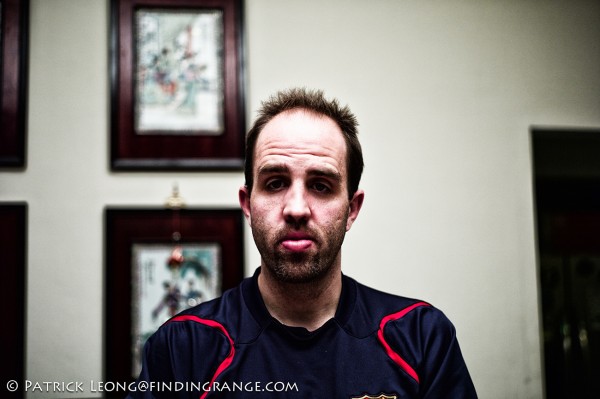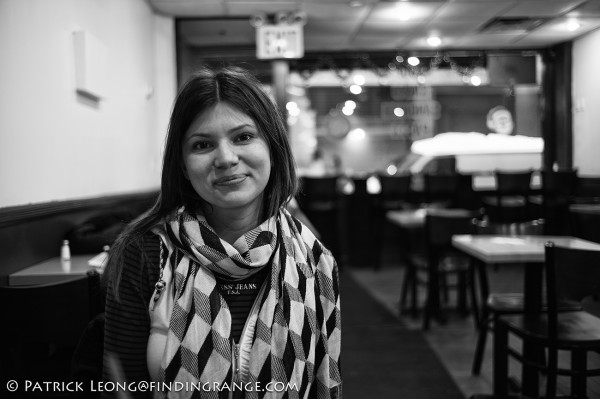A Leica 35 Summicron For Portraits?:
The 35mm focal length is probably the most popular focal length for Leica M’s. There are several reasons for this: a 35mm is wide enough to fit everything in the frame but isn’t completely effected with the negative effects associated with wider angles. Because it is a wide angle, it’s also easier to learn how to pre focus. A 35mm can also focus closer to get that “up close and personal” feel. There are several other reasons for why Leica owners prefer the 35mm as their main focal length but this post is not about that; it’s about using the 35 Summicron (Version 4, IV or 7-element) or as some refer to as the “Bokeh King” to take portraits. (By the way, I will be doing an extensive review of the 35 Summicron Version 4 at a later date. This post is just a sneak peak at what this lens can do).
With so many nice portrait lenses produced by Leica, such as the 75 Summilux (which I reviewed here) or my favorite, the 50 Summilux ASPH, why bother using a 35 Summicron? It’s not exactly flattering to use a wide angle. Well, sometimes you’re in a tight area, and you can’t fit everything in the frame. Other times: you just don’t want to kill the moment. My 35 Summicron is attached to my camera a lot…sometimes a moment comes along, and you just don’t want to ruin it by changing your lens. Us Leica people are use to fix focal lengths, and we make due :). Lastly, my biggest reason for using a 35mm for portrait? I actually like using a 35mm, particularly a 35 Summicron because it’s so small and non-threatening. It really brings you in close to your subject (which is a huge reason to use a Leica), and people don’t get intimidated by my Leica M9 (check out my M9 review here) and 35 Summicron combo.
 ↑ Up close and personal: What a Leica M9 and 35 Summicron were made for.
↑ Up close and personal: What a Leica M9 and 35 Summicron were made for.
Portrait Shots With The Leica 35 Summicron “Bokeh King”:
The idea for this post actually came to me a couple of hours ago when I was busy organizing my hard drives, which are completely filled with photos and a complete mess :). I kept running into portraits I took, and I was surprised that a lot of them came from my 35 Summicron Version 4. I have two copies of the 35 Summicron ASPH, and ASPH version is actually my preferred 35mm. I really like it better than my Version 4. I think it performs better, and I personally like the bokeh better. But I shoot more portraits with my Version 4 than my ASPH version, which leads me me ask the question: is there something about the older 35mm that makes me always come back to it for portraits?
 ↑ Here’s a photo that came straight out of Camera Raw with no photoshop done. The 35 Summicron Version 4 produces very smooth images that aren’t as contrasty as the newer ASPH version. I think the fact that it’s less contrasty helps here.
↑ Here’s a photo that came straight out of Camera Raw with no photoshop done. The 35 Summicron Version 4 produces very smooth images that aren’t as contrasty as the newer ASPH version. I think the fact that it’s less contrasty helps here.
So what makes me use this lens for portraits? I think its the imperfections that makes the 35 Summicron Version 4 produce such pleasing portraits. Don’t get me wrong; it’s an amazing lens with very few imperfections but the 35 Summicron ASPH is a better lens, and has definitely improved on the 35 Summicron Pre-ASPH. But the fact that the 35 Summicron Version 4 is less contrasty, less sharp, and there is more coma and stigmatism (which actually helps create the beautiful bokeh) contributes to this lens’ unique characteristics especially for portrait work. All of this combines, and creates a lens with a beautifully unique signature, that IMO, is hard to find in any lens from any manufacturer nowadays. As I said before, I have two copies of the 35 Summicron ASPH (a painted black on and a silver one) but I can’t seem to sell my Version 4. I just don’t want to let it go because the Pre-ASPH version really has a nice character to it.

↑ The 35 Summicron Version 4 might not be as sharp as it’s ASPH brother but it does offer a lot of character.
Portraits shot with this lens wide open are especially appealing. All of these portraits in this post were shot wide open, and look at them: There really is something nice about the 35 Summicron Pre-ASPH especially when shooting wide open. It’s definitely not as perfect when shot wide open when compared to the 35 Summicron ASPH but I think that’s what makes photos shot with the pre-ASPH so pleasing. Sometimes things are just too perfect, and a little imperfection can help. While I think the ASPH is superior to the pre-ASPH version, the pre-ASPH version has a certain character to it that seems to be lost in the newer ASPH version. Don’t miss understand me, there is character to the ASPH version; it’s just different. I believe that the bokeh in the ASPH is better but there is something nice…kind of sensual about the bokeh in the pre-ASPH version that’s not found in the newer ASPH version. The ASPH version offers a creamier bokeh but the pre-ASPH offers a smoother look that really helps flatter the subject in the photograph. It’s softer, less contrasty, less perfect, and the word that comes to me is delicate, which is something you’re really looking for in portraits. The new ASPH version is perfect in every way but with that perfection comes the newer Leica look to it. I love the new Leica look. The ASPH is insanely sharp, contrasty, and perfect…but sometimes it’s just nice to have a little imperfection, and that’s where the Pre-ASPH comes in.
 ↑ I love this photo because it has such an old school, Audrey Hepburn look to it.
↑ I love this photo because it has such an old school, Audrey Hepburn look to it.
 ↑ The 7-Element 35 Summicron is not as contrasty as the ASPH version but I like that sometimes.
↑ The 7-Element 35 Summicron is not as contrasty as the ASPH version but I like that sometimes.

↑ Just because the pre-ASPH version is not as sharp as the ASPH version doesn’t mean it’s dull. If you never used the ASPH version you would never feel the need for anything sharper.
Last Words on The Leica 35 Summicron Pre-ASPH:
Well…last words for now at least :). I will definitely be writing a more extensive review on the 35 Summicron Pre-ASPH with plenty of examples in the near future. I’m pretty sure many of you like this lens especially those of you who are new to Leica, and want to save some money after buying something like a Leica M9. This is a great lens with plenty of character, and ideal for portrait work even though it’s a 35mm. I love how my subjects look when shot with this lens. There is something special about this lens…Dare I say it…The 35 Summicron pre-ASPH has got a little magic :). Anyway, for now, I hope you enjoyed the photos, and here’s a couple more.
 ↑ The 35 Summicron Pre-ASPH has a really nice glow.
↑ The 35 Summicron Pre-ASPH has a really nice glow.
 ↑ Images are always nice and smooth with the 7-element 35 Summicron. This lens can definitely compete with the best of them still to this day.
↑ Images are always nice and smooth with the 7-element 35 Summicron. This lens can definitely compete with the best of them still to this day.


Hi, just wondering, does your V4 ‘Cron show a full circle aperture when opened to f2.0?
Hi David,
Yes, my cron does show a full circle when shot wide open. Thanks for stopping by.
@ patrick : should be not full circle… the wide open irish diafragma of cron never rounded…. you should recheck it again…
Hi Ethan,
Thanks for your comment. I’ll recheck when I get my new M. I sold my M9 a while back. Thanks for the info, take care.
Zeiss Biogon 35 is better than summicron.
Hi there!
You are saying in this post that you are going to do an extensive review of the Version 4.
I’ve been looking but can’t find it on your site. Is there an extensive review?
Kind Regards
Hi Bjarni,
Great to hear from you again! Sorry for the confusion. I wrote part of it but I got really busy and therefore, never finished it. But I promise it is still coming out! But in the mean time, if you’re looking for more M lens reviews, stay tuned. My 21mm Summilux ASPH Review will be out this week. It will be one of my biggest reviews ever with plenty of photos. I’ve been working on it all weekend :). Again, sorry for the confusion! Btw, how is your 35mm Cron?
Best regards,
Patrick
Hi Patrick!
Ok, i see. Looking forward to the review.
Looking forward to the review of the Summilux 21 mm as well, although i’m afraid i will get more tempted, since i’ve seen so many good reviews of the lens.
The problem with the hood on my 35 mm ASPH was fixed, but when i got the lens back from Leica, the aperture ring was rather wobbly, so i will have to send it back one more time.
I’m asking about the 35 mm Version IV, because i’m wondering how good it is on a new, digital body.
Somewhere i have seen reviews, saying the Version IV isn’t living up to todays standards for lenses, while i have seen some other reviews saying it’s much better than todays lenses. Different opinions everywhere.
I’m thinking about pairing it with the Monochrom or wait some months for the Monochrom Mk II.
What’s your experience. Just how good is the Version IV? Will it stand the test with a digital Leica, in regards to micro details? Sharpness? Rendering?
Or is it simply so old, that it in no means can deliver qualities and take the battle vs. the newer lenses?
You don’t happen to have some fullsize images i can see, for closer inspection?
All the best.
Hi Bjarni,
It’s nice to hear from you as always and sorry for the late reply! I am just about finished with my 21mm Summilux review, and it should be up on my site tomorrow.
Sorry to hear about your problems with the 35mm Cron. I hope this time, they fix it correctly. Please keep me updated as I would like to know how everything turns out. But I wouldn’t worry so much; once everything is fixed, you shouldn’t have any problems. To this day, I still haven’t sent a lens of mine in for repair.
The Version 4 is excellent on a digital body. In fact, I sold a large mounted print to someone a while back taken with the M 240 and this lens (if I remember correctly, it was larger than 16×24) and everything was tack sharp. I couldn’t ask for more. The newer Leica lenses will give you better performance but what makes the Version 4 still relevent in today’s photography is the fact that you will get fantastic image quality in a very compact body. There is no current Leica lens that has such a compact frame. It was my “go to” 35mm for many years. With the Monochrom, I would suggest pairing it with the ASPH version for ultimate sharpness, since the Monochrom resolves so well. But in my opinion, the Version 4 is still a fantastic lens and can still rival a lot of current lenses.
As for full size images, unfortunately, I don’t have those hard drives with me, and I probably won’t get them back until a month later. I stored them at my sister’s place and she’s currently away. I also loaned her the lens for her trip. Otherwise, I would’ve just taken you some sample shots. When I get the lens back, I can take a few sample shots for you.
Best regards,
Patrick
Hello,
Your portraits at f/2 seem very smooth indeed, to such a point that it is 100% certain that you have missed the focus. Typical user error with the cron v4 used on a digital full frame, because there is some slight focus shift with this cron v4. Not a lot of shift, but it is there.
If you take this phenomenon into account, and correct the focus accordingly, there will not be any difference in sharpness with the asph. I have done extensive tests with a lux pre-asph, cron pre-asph v4, Zeiss, 35 asph, cron pre-asph v1, and the most consistent of all has been the Cron v4.
Hi Oliver,
Good to hear from you. It took me a while to find the pics since this post is so old but I didn’t miss focus. I never had any issues with my V4. Its one of the reasons I still keep it after all these years. But you bring up an interesting point, so maybe I’ll do a comparison test in the future. Thanks for stopping by!
Best regards,
Patrick
There is a LOT of Nostalgia here because if that lens is the Bokeh King then what do you call the Sigma 35mm 1.2 Art which absolutely blows this lens away in everything from sharpness to Bokeh smoothness???
I’d call it “clinically boring”.